Background
The Nova Scotia Duck Tolling Retriever is unlike most any other hunting dog. Instead of chasing ducks, these dogs actually lure them closer by “dancing” along the shore. This graceful dancing technique is known as “tolling,” thus the breed name.
“Tolling” is a Middle English word and implies that the game is being tempted to come closer. The breed was taught how to do it by Canada’s Micmac Indians, who were impressed by the way foxes were able to entice prey in a similar fashion. They were originally called Little River Duck Dogs.
The Nova Scotia Duck Tolling Retriever was recognized by the American Kennel Club in 2003.
Sizing up
- Weight: 35 to 50 lbs.
- Height: 17 to 21 inches
- Coat: Double, water-repellent coat, medium in length
- Color: Red, fawn and red-gold all with white markings
- Life expectancy: 12 to 14 years
What’s the Nova Scotia Duck Tolling Retriever like?
The Nova Scotia Duck Tolling Retriever is an active, independent and spunky little redhead with an admiration of children and a fierce love of his family. They also have the natural skills of a trustworthy watchdog.
The Toller is definitely a breed needing regular human companionship. When left alone for too long he can get a bit destructive. The best way to protect your possessions is to exercise him frequently.
He can be a howler and the littlest thing, like a bird flying by the window, can get him excited. Neighbors in close quarters may not appreciate this.
The Toller is a smart little dog, and will learn quickly, but you’ll definitely need to show him you’re the boss. Otherwise he could use his intelligence against you. Always begin training the day you bring him home and use firm and consistent techniques as well as praises and food rewards when he’s done something correctly. Socializing should begin at an early age, he’ll have a great time at a dog park or at doggie daycare.
Grooming your Toller is pretty easy. You’ll need to give him a good brushing about twice a week or as needed to keep his coat free of tangles and mats. Brushing also helps keep his shedding down.
Health
The Nova Scotia Duck Tolling Retriever is generally a healthy breed with a few concerns to watch for:
Hip dysplasia
- One of the most common diseases seen in dogs, with larger breeds being the most affected. It is ultimately a malfunction of the hip joints.
- A knee condition where one or both kneecaps can accidentally slip out of place
- An eye condition that essentially worsens over time and could lead to a loss of vision
- A disease caused by a decrease in metabolism due to an under-active thyroid hormone
Addison’s disease
Takeaway points
- The Nova Scotia Duck Tolling Retriever makes a great watchdog.
- The Nova Scotia Duck Tolling Retriever thrives best with a family who is as active and loving as he is.
- The Nova Scotia Duck Tolling Retriever is good with children, as long as they are respectful.
- The Nova Scotia Duck Tolling Retriever is very easy to train.
If you have any questions or concerns, you should always visit or call your veterinarian -- they are your best resource to ensure the health and well-being of your pets.
